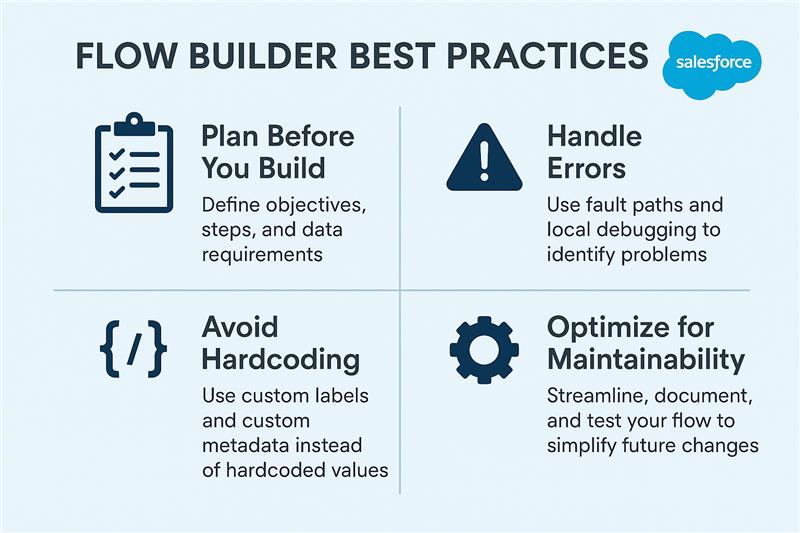Flow Builder Best Practices in Salesforce
Salesforce Flow Builder has quickly become the go-to automation tool in the Salesforce ecosystem, replacing Workflow Rules and Process Builder. With its power and flexibility, Flows can automate business processes, integrate with external systems, and provide dynamic user experiences. However, with great power comes great responsibility—poorly designed Flows can lead to performance issues, maintenance challenges, and user frustration.
In this blog, we’ll dive into the best practices for building Flows in Salesforce that are scalable, maintainable, and optimized for performance.
1. Plan Before You Build
One of the biggest mistakes admins and developers make is jumping straight into Flow Builder. Take the time to:
- Understand the business process end-to-end.
- Identify decision points and data updates.
- Decide if Flow is the right tool (vs Apex, Validation Rules, etc.).
- Sketch the flow on paper or a diagramming tool before implementation.
2.Use Subflows for Reusability
Instead of duplicating logic in multiple Flows, create Subflows and call them where needed. For example:
- A subflow for creating related records.
- A subflow for sending email alerts.
- A subflow for updating account hierarchies.
This reduces redundancy and simplifies maintenance.
3. Bulkify Your Flows
Flows often run in bulk (especially Record-Triggered Flows). To avoid hitting Salesforce limits:
- Use Get Records carefully (query only what you need).
- Avoid looping over records unnecessarily.
- Use Assignments and Collections to update records in bulk instead of one by one.
Example: Collect multiple records in a list and use a single Update Records element instead of multiple updates inside a loop.
4. Minimize the Number of Flow Triggers
Avoid having multiple Record-Triggered Flows on the same object. Salesforce best practice is:
- One before-save Flow per object.
- One after-save Flow per object.
If you must use multiple, carefully control the trigger order using Flow Trigger Explorer.
5. Use Naming Conventions
Consistent naming makes your Flows easy to read and maintain.
- Elements: Prefix with type (e.g., DEC_CheckStatus, ASS_UpdateOpportunity).
- Variables: Use camelCase (e.g., accountId, contactList).
- Flows: Name them by purpose (e.g., Account_BeforeSave_Validation).
6. Handle Errors Gracefully
Unexpected errors are inevitable, so always plan for them:
- Use Fault Paths on elements like Get Records, Update, or Create.
- Send error details to an admin via email or create a custom Error Log object.
- Display meaningful error messages to end-users in Screen Flows.
7. Avoid Hardcoding IDs and Values
Hardcoding record IDs (like Record Types, Queue IDs, or Profile IDs) creates maintenance nightmares. Instead:
- Use Custom Metadata Types (CMDT).
- Use Custom Settings or Labels for static values.
- Query for IDs dynamically when needed.
8. Document Your Flow
Future you (or another admin) will thank you if you:
- Use Description fields on every element.
- Comment on complex logic.
- Maintain a separate Flow Design Document with version history.
9. Test Thoroughly in Sandboxes
Never deploy a Flow without testing in a Sandbox. Steps to follow:
- Test with different record types, users, and profiles.
- Test bulk operations (Data Loader, Mass Update).
- Use debug mode to step through the flow.
Also, create Flow Tests (Beta) in Salesforce for automated testing of Record-Triggered Flows.
10. Monitor & Optimize Performance
After deployment:
- Use Debug Logs and Flow Interviews to troubleshoot.
- Regularly review performance in high-volume orgs.
- Archive or deactivate unused Flows to reduce clutter.
Conclusion
Salesforce Flow Builder is one of the most powerful automation tools available to admins and developers today. By following these best practices—planning, bulkifying, reusing subflows, handling errors, and avoiding hardcoding—you can build Flows that are not only functional but also scalable, user-friendly, and future-proof.
Automation is only as good as its design. A well-built Flow can save hours of manual work, improve data quality, and deliver a seamless user experience. Poorly built Flows, however, can cause frustration and system inefficiency.
👉 The choice is yours: build smart, scalable Flows and unlock the full potential of Salesforce automation.

